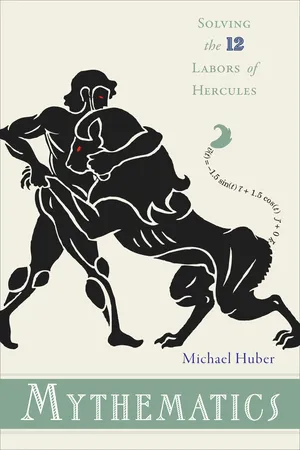
- 216 pages
- English
- ePUB (mobile friendly)
- Available on iOS & Android
About This Book
Fun math puzzles based on the Twelve Labors of Hercules How might Hercules, the most famous of the Greek heroes, have used mathematics to complete his astonishing Twelve Labors? From conquering the Nemean Lion and cleaning out the Augean Stables, to capturing the Erymanthean Boar and entering the Underworld to defeat the three-headed dog Cerberus, Hercules and his legend are the inspiration for this book of fun and original math puzzles.While Hercules relied on superhuman strength to accomplish the Twelve Labors, Mythematics shows how math could have helped during his quest. How does Hercules defeat the Lernean Hydra and stop its heads from multiplying? Can Hercules clean the Augean Stables in a day? What is the probability that the Cretan Bull will attack the citizens of Marathon? How does Hercules deal with the terrifying Kraken? Michael Huber's inventive math problems are accompanied by short descriptions of the Twelve Labors, taken from the writings of Apollodorus, who chronicled the life of Hercules two thousand years ago. Tasks are approached from a mathematical modeling viewpoint, requiring varying levels of knowledge, from basic logic and geometry to differential and integral calculus. Mythematics provides helpful hints and complete solutions, and the appendixes include a brief history of the Hercules tale, a review of mathematics and equations, and a guide to the various disciplines of math used throughout the book.An engaging combination of ancient mythology and modern mathematics, Mythematics will enlighten and delight mathematics and classics enthusiasts alike.
Frequently asked questions
Information
CHAPTER 1


The First Labor: The Nemean Lion
From Apollodorus:First, Eurystheus ordered him to bring the skin of the Nemean lion; now that was an invulnerable beast begotten by Typhon. On his way to attack the lion he came to Cleonae and lodged at the house of a day-laborer, Molorchus; and when his host would have offered a victim in sacrifice, Hercules told him to wait for thirty days, and then, if he had returned safe from the hunt, to sacrifice to Saviour Zeus, but if he were dead, to sacrifice to him as to a hero. And having come to Nemea and tracked the lion, he first shot an arrow at him, but when he perceived that the beast was invulnerable, he heaved up his club and made after him. And when the lion took refuge in a cave with two mouths, Hercules built up the one entrance and came in upon the beast through the other, and putting his arm round its neck held it tight till he had choked it; so laying it on his shoulders he carried it to Cleonae. And finding Molorchus on the last of the thirty days about to sacrifice the victim to him as to a dead man, he sacrificed to Saviour Zeus and brought the lion to Mycenae. Amazed at his manhood, Eurystheus forbade him thenceforth to enter the city, but ordered him to exhibit the fruits of his labours before the gates. They say, too, that in his fear he had a bronze jar made for himself to hide in under the earth, and that he sent his commands for the labours through a herald, Copreus, son of Pelops the Elean. This Copreus had killed Iphitus and fled to Mycenae, where he was purified by Eurystheus and took up his abode.
1.1. The Tasks
1.1.1. Shooting an Arrow
1.1.2. Hercules Closes the Cave Mouth
1.1.3. Exercise: Zeus Makes a Deal
1.2. The Solutions
1.2.1. Shooting an Arrow
From Apollodorus:First, Eurystheus ordered him to bring the skin of the Nemean lion; now that was an invulnerable beast begotten by Typhon. On his way to attack the lion he came to Cleonae and lodged at the house of a day-laborer, Molorchus; and when his host would have offered a victim in sacrifice, Hercules told him to wait for thirty days, and then, if he had returned safe from the hunt, to sacrifice to Saviour Zeus, but if he were dead, to sacrifice to him as to a hero. And having come to Nemea and tracked the lion, he first shot an arrow at him.






Table of contents
- Cover
- Title
- Copyright
- Dedication
- List of Figures
- Foreword
- Chapter 1 The First Labor: The Nemean Lion
- Chapter 2 The Second Labor: The Lernean Hydra
- Chapter 3 The Third Labor: The Hind of Ceryneia
- Chapter 4 The Fourth Labor: The Erymanthian Boar
- Chapter 5 The Fifth Labor: The Augean Stables
- Chapter 6 The Sixth Labor: The Stymphalian Birds
- Chapter 7 The Seventh Labor: The Cretan Bull
- Chapter 8 The Eighth Labor: The Horses of Diomedes
- Chapter 9 The Ninth Labor: The Belt of Hippolyte
- Chapter 10 The Tenth Labor: Geryon’s Cattle
- Chapter 11 The Eleventh Labor: The Apples of the Hesperides
- Chapter 12 The Twelfth Labor: Cerberus
- Appendix A: The Labors and Subject Areas of Mathematics
- Appendix B: Hercules before the Labors
- Appendix C: The Authors of the Hercules Myth
- Appendix D: The Laplace Transform
- Appendix E: Solution to the Sudoku Puzzles
- Bibliography
- Index